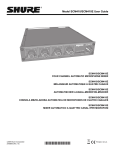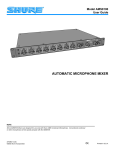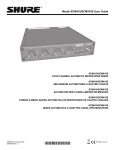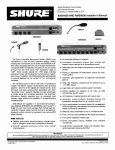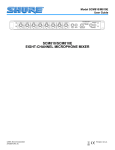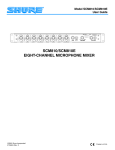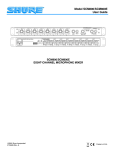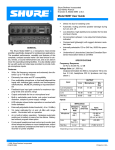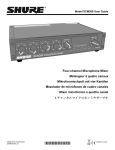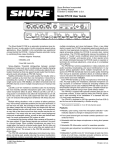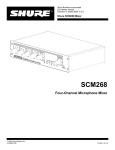Download Shure AMS8100 User guide
Transcript
Shure Brothers Incorporated 222 Hartrey Avenue Evanston IL 60202-3696 U.S.A. Model SCM410/SCM410E User Guide SCM410/SCM410E FOUR CHANNEL AUTOMATIC MICROPHONE MIXER 1999, Shure Brothers Incorporated 27A8690 (SG) U.S. Patents 4,658,425; 5,297,210 Printed in U.S.A. TABLE OF CONTENTS DESCRIPTION . . . . . . . . . . . . . . . . . . . . . . . . . . . . . . . . . . . . . . . . . . . . . . . . . . . . . . . . . . . . . . . . . . . . . . . . . . . . . . . . . . . . . . . . . . . . . . 3 FEATURES . . . . . . . . . . . . . . . . . . . . . . . . . . . . . . . . . . . . . . . . . . . . . . . . . . . . . . . . . . . . . . . . . . . . . . . . . . . . . . . . . . . . . . . . . . . . . . 3 OPERATING PRINCIPLES . . . . . . . . . . . . . . . . . . . . . . . . . . . . . . . . . . . . . . . . . . . . . . . . . . . . . . . . . . . . . . . . . . . . . . . . . . . . . . . . 3 FRONT PANEL . . . . . . . . . . . . . . . . . . . . . . . . . . . . . . . . . . . . . . . . . . . . . . . . . . . . . . . . . . . . . . . . . . . . . . . . . . . . . . . . . . . . . . . . . . 3 REAR PANEL . . . . . . . . . . . . . . . . . . . . . . . . . . . . . . . . . . . . . . . . . . . . . . . . . . . . . . . . . . . . . . . . . . . . . . . . . . . . . . . . . . . . . . . . . . . . 4 DIP SWITCH FUNCTIONS . . . . . . . . . . . . . . . . . . . . . . . . . . . . . . . . . . . . . . . . . . . . . . . . . . . . . . . . . . . . . . . . . . . . . . . . . . . . . . . . 4 INSTALLATION . . . . . . . . . . . . . . . . . . . . . . . . . . . . . . . . . . . . . . . . . . . . . . . . . . . . . . . . . . . . . . . . . . . . . . . . . . . . . . . . . . . . . . . . . . . . . . 5 SUPPLIED HARDWARE . . . . . . . . . . . . . . . . . . . . . . . . . . . . . . . . . . . . . . . . . . . . . . . . . . . . . . . . . . . . . . . . . . . . . . . . . . . . . . . . . . 5 RACK MOUNTING . . . . . . . . . . . . . . . . . . . . . . . . . . . . . . . . . . . . . . . . . . . . . . . . . . . . . . . . . . . . . . . . . . . . . . . . . . . . . . . . . . . . . . . 5 TABLE-TOP MOUNTING . . . . . . . . . . . . . . . . . . . . . . . . . . . . . . . . . . . . . . . . . . . . . . . . . . . . . . . . . . . . . . . . . . . . . . . . . . . . . . . . . . 6 FIXED MOUNTING . . . . . . . . . . . . . . . . . . . . . . . . . . . . . . . . . . . . . . . . . . . . . . . . . . . . . . . . . . . . . . . . . . . . . . . . . . . . . . . . . . . . . . . 6 SCM410 CONNECTIONS . . . . . . . . . . . . . . . . . . . . . . . . . . . . . . . . . . . . . . . . . . . . . . . . . . . . . . . . . . . . . . . . . . . . . . . . . . . . . . . . . 7 LINKING MULTIPLE MIXERS . . . . . . . . . . . . . . . . . . . . . . . . . . . . . . . . . . . . . . . . . . . . . . . . . . . . . . . . . . . . . . . . . . . . . . . . . . . . . . 7 BASIC OPERATION . . . . . . . . . . . . . . . . . . . . . . . . . . . . . . . . . . . . . . . . . . . . . . . . . . . . . . . . . . . . . . . . . . . . . . . . . . . . . . . . . . . . . . . . . . 8 LIMITER . . . . . . . . . . . . . . . . . . . . . . . . . . . . . . . . . . . . . . . . . . . . . . . . . . . . . . . . . . . . . . . . . . . . . . . . . . . . . . . . . . . . . . . . . . . . . . . . 8 EQUALIZER FUNCTIONS . . . . . . . . . . . . . . . . . . . . . . . . . . . . . . . . . . . . . . . . . . . . . . . . . . . . . . . . . . . . . . . . . . . . . . . . . . . . . . . . . 8 SPECIFICATIONS . . . . . . . . . . . . . . . . . . . . . . . . . . . . . . . . . . . . . . . . . . . . . . . . . . . . . . . . . . . . . . . . . . . . . . . . . . . . . . . . . . . . . . . . . . . . 9 ADVANCED FUNCTIONS . . . . . . . . . . . . . . . . . . . . . . . . . . . . . . . . . . . . . . . . . . . . . . . . . . . . . . . . . . . . . . . . . . . . . . . . . . . . . . . . . . . . 11 LOGIC CONNECTION SPECIFICATIONS . . . . . . . . . . . . . . . . . . . . . . . . . . . . . . . . . . . . . . . . . . . . . . . . . . . . . . . . . . . . . . . . . . 11 SUGGESTED LOGIC APPLICATIONS . . . . . . . . . . . . . . . . . . . . . . . . . . . . . . . . . . . . . . . . . . . . . . . . . . . . . . . . . . . . . . . . . . . . 12 INTERNAL MODIFICATIONS . . . . . . . . . . . . . . . . . . . . . . . . . . . . . . . . . . . . . . . . . . . . . . . . . . . . . . . . . . . . . . . . . . . . . . . . . . . . . . . . 15 WARNING: Voltages in this equipment are hazardous to life. No user-serviceable parts inside. Refer all servicing to qualified service personnel. The safety certifications do not apply when the operating voltage is changed from the factory setting. This symbol indicates that dangerous voltage constituting a risk of electric shock is present within this unit. This symbol indicates that there are important operating and maintenance instructions in the literature accompanying this unit. 2 DESCRIPTION Each input channel has a two-band equalizer and three logic terminals. The equalizer reduces unwanted low-frequency audio pickup and makes different microphone types—lavaliers, boundary and handheld—sound similar. The logic terminals can be used to control external devices. The Shure Model SCM410/E is a four-channel automatic microphone mixer designed for use in sound reinforcement, audio recording, and broadcast applications. The SCM410 dramatically improves audio quality in any application where multiple microphones are required. Any low-impedance dynamic or condenser microphone (including wireless) can be used with the SCM410. Multiple SCM410 mixers can be linked to other SCM410 mixers, as well as to Shure Models FP410, SCM810, SCM800, and AMS8100 mixers. The SCM410 operates on 100–120 Vac power and the SCM410E operates on 220–240 Vac power. Each mixer is supplied with a power cord, rack-mounting hardware, and a link cable. FEATURES • Fast, noise-free microphone selection, which automatically • Active balanced microphone-level XLR inputs and an active adjusts to changes in background noise balanced Mic/Line level XLR output • Automatic gain adjustment as additional microphones are ac- • Unbalanced auxiliary-level phono output • Bi-color channel activation and clipping LEDs • Peak-responding output limiter with LED indicator • Peak-responding output level meter tivated–NOMA (Number of Open Microphones Attenuated) • Last Mic Lock-On circuit maintains ambient sound • Fits in half-rack space • Adjustable EQ for each channel OPERATING PRINCIPLES The operating concept behind the SCM410 Automatic Mixer is Shure’s patented* IntelliMix circuitry. Intellimix delivers seamless automatic mixing by combining three separate functions: • MaxBus. Controls the number of channels that may be acti- • Noise Adaptive Threshold. Distinguishes between constant • Last Mic Lock-On. Keeps the most recently activated mi- vated for a single sound source. One talker activates only one channel, even if multiple microphones “hear” that talker. background noise (such as air conditioning) and changing sound (such as speech) for each input channel. It continuously adjusts the activation threshold so that only speech levels louder than the background noise activate a channel. crophone open until another microphone is activated. Without Last Mic Lock-On, a long pause in conversation would cause all microphones to turn off, which would sound as if the audio signal had been lost. Last Mic Lock-On ensures that background ambience is always present. FRONT PANEL MODEL SCM410 FRONT PANEL FIGURE 1 1. Microphone Channel Gain Controls 1 - 4: Allows adjustment of microphone gain. 2. Input LED 1 - 4: Lights green when channel is active; lights red at 6 dB below clipping level. 3. Low-Cut Filter 1 - 4: Provides adjustable low-frequency rolloff (high pass), reducing presence of undesirable low-frequency signals. 4. High-Frequency Shelving Filter 1 - 4: Provides level boost or cut in mid/high-frequency region for reduced sibilance from vocal microphones, or to compensate for off-axis coloration in lavalier microphones. 5. Output Level Meter: Six-segment LED meter indicates peak output signal level in dBu (0 dBu = 0.775V). The red LED illuminates when the output is 6 dB below clipping. The last LED indicates limiter action. 6. MASTER Level Control: Controls overall output level. 7. POWER LED: Lights green when mixer is plugged into a power source. *U.S. Patents 4,658,425 and 5,297,210. IntelliMix is a registered trademark of Shure Brothers Incorporated. 3 REAR PANEL MODEL SCM410 REAR PANEL FIGURE 2 1. Power Connector: Unit is energized when the power cord is plugged into a 100–120 Vac (SCM410) or 220–240 Vac (SCM410E) power source. Can be internally modified.Refer to the “Internal Modification” section. NOTE: There is no power On/Off switch on this mixer. 4. AUX OUT Phono Connector: Feeds consumer-level audio equipment, such as a tape recorder, VCR, or video camera. Not affected by MIC/LINE switch. 2. DIP Switch: The 4-position DIP switch provides additional functions. Refer to the “DIP Switch Functions”section. 6. LINK IN/OUT Connector: Permits multiple SCM410/E, SCM810, SCM800, or AMS8100 mixers to be linked, creating additional inputs. 5. MIC/LINE XLR OUTPUT Connector: Can be set for microphone or line-level output via a DIP switch. 3. Microphone Logic Connector: High density DB-15 male connector provides connection to GATE OUT, MUTE IN, and OVERRIDE IN logic terminals on each channel. Refer to the “Advanced Functions” section. NOTE: THIS IS NOT A VGA MONITOR PORT. 7. MIC LEVEL XLR INPUT Connectors: Active balanced microphone-level XLR inputs. For instructions on how to modify the level of these inputs, refer to the “Internal Modifications” section. DIP SWITCH FUNCTIONS The rear panel DIP switches, shown in Figure 3, provide the functions listed in the table below. (MIXER REAR PANEL) Last Mic Lock-On: Keeps the most recently activated microphone turned on until another microphone is activated. When defeated, microphones turn off after their default hold time. XLR Output Level: Sets the level of the XLR output to line or microphone level. Make sure the output level matches the input level of the device connected to the SCM410. 1 2 3 4 NOTE: The output level does not affect the auxiliary output (AUX OUT) level. Limiter: Activates the output limiter and sets it to a default threshold of +16 dBu (see Internal Modifications for other threshold settings). DIP SWITCHES FIGURE 3 12V Phantom Power: When this switch is in the ON position, the SCM410 provides 12Vdc phantom power to each XLR microphone input. This function is particularly useful when using condenser microphones, since most condenser microphones require phantom power. DIP SWITCH FUNCTIONS Last Mic Lock-On XLR Output Level Limiter 12V Phantom Power Switch Number 1 2 3 4 Switch Up All mics off after hold time Mic Level ON ON Switch Down ON* Line Level* OFF* OFF* NOTE: Phantom power does not affect the operation of balanced dynamic microphones. They can be connected to the SCM410 in combination with condenser microphones that use phantom power. For instructions on how to disable phantom power by channel, refer to the “Internal Modifications” section. *Factory setting. 4 INSTALLATION SUPPLIED HARDWARE 4 rubber feet 1 rackmount bracket, long 1 rackmount bracket, short 2 straddle brackets 10 bracket screws, 6 mm (1/4 in.) 4 rackmount screws, 2.54 cm (1 in.) 4 plastic washers 4 wood screws, 1.25 cm (1/2 in.) RACK MOUNTING The SCM410 is supplied with hardware for mounting one or two units to a 19-inch audio equipment rack. The hardware can also be used to rack mount other Shure products, including the SCM268, SCM262, DFR11EQ, and the DP11EQ. Dual Mixer (Full Rack) Installation 1. Place the two mixers side-by-side and connect them with two (2) straddle brackets. The brackets should straddle the recessed edges on the top and bottom of each mixer. See Figure 6. Single Mixer (Half Rack) Installation 1. Attach the short and long rackmount brackets to the SCM410/E with eight (8) of the supplied bracket screws, as shown in Figure 4. INSTALLING STRADDLE BRACKETS FIGURE 6 2. Fasten the straddle brackets using eight (8) bracket screws. INSTALLING HALF–RACK MOUNTING BRACKETS FIGURE 4 3. Attach the short rackmount brackets to the outsides of the combined mixers with eight (8) of the bracket screws. See Figure 7. 2. Place the mixer in an equipment rack and secure it with the supplied rackmount screws and plastic washers. See Figure 5. INSTALLING FULL–RACK MOUNTING BRACKETS FIGURE 7 4. Place the mixer in an equipment rack, using the supplied rackmount screws and plastic washers. See Figure 8. RACK MOUNTING A SINGLE SCM410/E MIXER FIGURE 5 RACK MOUNTING DUAL SCM410/E MIXERS FIGURE 8 5 TABLE-TOP MOUNTING Adhere the four (4) supplied rubber feet to the bottom of the mixer at each corner, as shown in Figure 9. This will keep it from sliding and protect the table surface. ATTACHING RUBBER FEET FOR TABLE–TOP MOUNTING FIGURE 9 FIXED MOUNTING Top Mount Hanging Mount 1. Fasten the straddle brackets to the recessed edges of the chassis, using four (4) bracket screws, as shown in Figure 10. 1. Fasten the straddle brackets to the top of the mixer, as shown in Figure 12. INSTALLING STRADDLE BRACKETS FOR TOP MOUNTING FIGURE 10 INSTALLING STRADDLE BRACKETS FOR HANG MOUNTING FIGURE 12 2. Fasten the straddle brackets to the top of the mounting surface, using the four (4) supplied wood screws. See Figure 11. 2. Fasten the straddle brackets to the bottom of the mounting surface, using the four (4) supplied wood screws. See Figure 13. SECURING MIXER TO TOP MOUNTING SURFACE FIGURE 11 SECURING MIXER TO BOTTOM MOUNTING SURFACE FIGURE 13 6 SCM410 CONNECTIONS 3. Connect the SCM410 Mic/Line Level Output to the input of mixers, EQs, amplifiers or recorders. 1. Connect microphone signal sources to the Channel Input connectors, as shown in Figure 14. Use conventional 2-conductor shielded audio cables. 4. Connect the power cord to 100–120 Vac (SCM410) or 220–240 Vac (SCM410E). 2. If any condenser microphones are connected, set the +12V phantom power DIP switch to ON. Ï Ï SHURE OR Á SCM410 CONNECTIONS FIGURE 14 LINKING MULTIPLE MIXERS If more than four inputs are needed, multiple Shure SCM410, FP410, or SCM810 mixers can be linked by connecting the LINK OUT of the first mixer to the LINK IN of the next mixer, and so on. See Figure 15. Leave the LINK IN jack of the first mixer and the LINK OUT jack of the last mixer unconnected. light dimmers. To minimize ground currents, make sure linked mixers are connected to the same AC power mains. When properly linked, the mixers will operate as a system. Automatic mixing functions will be shared by all units. All input signals appear at all linked mixer outputs. Each mixer’s Master level control only controls its own output. However, actual offattenuation will increase as more mixers are linked. This reduces excessive noise and reverberation contributed by the increased number of microphones. IMPORTANT: When using logic terminals on linked mixers, connect the LOGIC GROUND terminals of each unit together. NOTE: SCM410 link connections are unbalanced. To minimize hum and noise, avoid using longer link cables. Use high quality, shielded cable, and keep them away from sources of magnetic or electrical noise, such as power transformers or LINKED SCM410 AND SCM810 MIXERS FIGURE 15 7 BASIC MIXER OPERATION 3. Adjust the Master level control for the required output level, as indicated by the output peak meter. The SCM410 is now ready for use. 1. Adjust each channel level so that its Overload LED flickers only during very loud speech or noise. 2. Adjust the Low-Cut and High-Frequency controls adjacent to each Input Gain control so that the microphones sound similar. NOTE: The sensitivity of the Intellimix circuitry may allow some channel gating due to static discharge or electrical disturbance to the power or signal lines. The unit will not be damaged; normal operation will resume after the disturbance ceases. LIMITER The limiter may be turned on via the rear panel DIP switch. The default limiter threshold is +16 dBu. As supplied, the limiter is defeated. Output limiters prevent distortion during loud program peaks without affecting normal program levels. This keeps the devices connected to the SCM410 output from becoming overloaded. Increasing individual or Master controls on the SCM410 increases average output and, in turn, the amount of limiting. NOTE: Limiter thresholds can be changed from their factory settings. Refer to the INTERNAL MODIFICATIONS section. EQUALIZER FUNCTIONS Low Cut Filter (High-Pass) High-Frequency Shelving Low-cut filters are used to reduce unwanted low frequency sounds such as footsteps, motorized traffic, and to control proximity effect. The SCM410 has a one-pole, low-cut (highpass) filter of 6 dB per octave. The low-cut filter allows all frequencies above its cutoff point to pass through unchanged. Frequencies below the cutoff are attenuated (see Figure 16). The cutoff point is defined as the frequency where the signal has dropped 3 dB relative to the flat, or bandpass, region. Below the cutoff point, the filter exhibits increasingly more attenuation as the frequency diminishes. The fixed-frequency equalizer produces a 6 dB boost or cut at 5 kHz and above (see Figure 17). High-frequency shelving is extremely useful for boosting flat frequency response and tempering sibilant vocal microphones or enhancing the sound of off-axis lavalier microphones. +10 +6 +4 AMPLITUDE (dB) +2 +2 FULL CW 0 FULL CW +8 50% ROTATE AMPLITUDE (dB) 0 -2 -2 -4 -4 -6 -8 -10 20 -6 FULL CCW 50% ROTATION -8 100 1,000 FULL CCW -10 5,000 200 FREQUENCY (Hz) 1,000 10,000 20,000 FREQUENCY (Hz) LOW-CUT FILTER EFFECTS FIGURE 16 HIGH-FREQUENCY SHELVING EFFECTS FIGURE 17 8 SPECIFICATIONS Measurement Conditions (unless otherwise specified): Line voltage 120 Vac, 60 Hz (SCM410) or 230 Vac, 50 Hz (SCM410E); full gain; 1 kHz, one channel activated; source impedances: Mic 150 Ω; terminations: Line/Mic Aux 10 kΩ Input LEDs Green on channel activation, red at 6 dB below clipping Phantom Power 12 Vdc open-circuit through 680 Ω resistors Operating Voltage SCM410: 100–120 Vac rated nominal, 50/60 Hz, 100 mA (maximum) SCM410E; 220-240 Vac rated niminal, 50/60 Hz, 50 mA (maximum) Mains Inrush Current (230 Vac, SCM410E only) 0.7 A peak Temperature Range Operating: -7° to 49° C (20° to 120° F ) Storage: -29° to 74° C (-20° to 165° F) Overall Dimensions 44 mm H x 219 mm W x 267 mm D (1-3/4 x 8-5/8 x 10-1/2 in.) Net Weight 1.75 kg (3.86 lbs) Certifications SCM410: UL listed to UL 6500 and cUL listed to E65 Canada. SCM410E: Conforms to applicable European Directives; eligible to bear CE marking. Low Voltage Directive 73/23/EEC: VDE GS-Certified to EN 60065. EMC Directive 89/336/EEC: Professional Audio Products Standard EN55103 (1996); Part 1 (Emissions) and Part 2 (Immunity). Electromagnetic Compatibility (EMC) Statement The SCM410E mixer is intended for use in E1 (residential) and E2 (light industrial) environments, as defined in European EMC standard EN 55103. It meets the applicable tests and performance criteria found in the standard for these environments. EMC conformance is based on the use of recommended and supplied cables. NOTE: Under certain circumstances, the SCM410E may be exposed to outside electromagnetic interference levels beyond what is typical in the intended environment. Should this occur, additional measures may be required to reduce interference to acceptable levels. The following table identifies possible sources of unwanted interference. Frequency Response (at 1 kHz, channel controls centered) 50 Hz to 20 kHz ±2 dB; -3 dB corner at 25 Hz Voltage Gain (typical, controls full clockwise) Output Input Line Mic Aux Low-impedance mic (150 Ω) 80 dB 40 dB 68 dB Inputs Impedance Input Designed for use with Actual (typical) Input Clipping Level Mic 19-600 Ω 1.4 kΩ -14 dBV Outputs Impedance Designed for use with Actual (typical) Output Clipping Level Line ≥5k Ω 300 Ω +24 dBV Mic ≥600 Ω 3Ω –18 dBV Aux ≥10k Ω 1.5 k Ω +14 dBV Output Total Harmonic Distortion <0.1% at +4 dBu output level, 50 Hz to 20 kHz (through 22 Hz to 22 kHz filter; Input at 12 o’ clock and Master at 12 o’ clock, all other controls full counterclockwise) Hum and Noise (150 Ω source; through 22 Hz to 22 kHz filter) Equivalent Input Hum and Noise: . -123 dBV max., 125 dBV typical Output Hum and Noise (channel controls full counterclockwise): Master full counterclockwise: -90 dBV Master full clockwise: -70 dBV Common Mode Rejection >70 dB at 1 kHz Polarity All inputs to all outputs are non-inverting Input Channel Activation Attack Time: 4 ms Hold Time: 0.4 s Decay Time: 0.5 s Off-Attenuation 13 dB Overload and Shorting Protection Shorting outputs, even for prolonged periods, causes no damage. Microphone inputs are not damaged by signals up to +10 dBV (3V) Equalization Low-frequency: 6 dB/octave cut, adjustable corner from 25 to 320 Hz High-frequency: ±6 dB at 5 kHz, ±8 dB at 10 kHz, shelving Limiter Type: Peak Threshold: +16 dBu (at output) Attack Time: 2 ms Recovery Time: 300 ms Indicator: Lights red when limiting occurs Decreased Signal-toNoise Ratio Erratic LED and/or Channel Operation Signal Distortion High RF Field (generated by nearby radio transmitter) X X X Electrostatic Discharge X X Magnetic Fields (close proximity to mains power lines or CRTs) X Mains Power Line Interruptions/Dips (poor power grid qualtiy/storms) Mains Surges and Line Transients (nearby lightning strikes/mains arcs) 9 X X X X X Replacement Parts Knob, Master (white) . . . . . . . . . . . . . . . . . . . . . . . 95A8238 Knob, Channel Gain (blue) . . . . . . . . . . . . . . . . . 95B8238 Line (Power) Cord (SCM410) . . . . . . . . . . . . . . . 95A8762 Line (Power) Cord (SCM410E) . . . . . . . . . . . . . . 95A8778 Link Cable . . . . . . . . . . . . . . . . . . . . . . . . . . . . . . . . 95A8889 Fuse, SCM410 (5 x 20 mm, T 125mA L, 250V, time delay) . . . 80C730 Fuse, SCM410E (5 x 20 mm, T 50mA L, 250V, time lag) . . . . . . 80C380 Long Rack Mount Bracket . . . . . . . . . . . . . . . . . . 53A8484 Short Rack Mount Bracket . . . . . . . . . . . . . . . . . . 53B8484 Straddle Bracket . . . . . . . . . . . . . . . . . . . . . . . . . . 53A8443 Bagged Hardware Kit . . . . . . . . . . . . . . . . . . . . . 90AA8100 Optional Accessories Line (Power) Cord, 230–240 Vac (UK) . . . . . . . . 95A8713 External 50 dB Line Pad . . . . . . . . . . . . . . . . . . . . . . A15LA Service Statement For additional service or parts information, contact the Shure Service Department at 1-800-516-2525. Outside the U.S.A., contact your authorized Shure Service Center. 10 ADVANCED FUNCTIONS CAUTION: Use of Advanced Functions is recommended only for qualified audio technicians. LOGIC CONNECTION SPECIFICATIONS The SCM410 logic functions expand the range of installation and control options. Logic can be used for everything from simple cough switches to elaborate computer-controlled room systems. (Shure’s AMS Update publication contains additional applications of advanced logic. This publication is available by contacting the Shure Applications Department.) The following logic functions are available for each channel: GATE OUT: Follows channel gating and goes to logic “low” (sinks current) when microphone is gated on. 500 mA of current sinking ability is provided (see Figure 18A). MUTE IN: Applying logic “low” (from GATE OUT or a switch closure to logic ground) gates channel off (see Figure 18B). Channel output drops to -∞. A B +5 V LOGIC CONNECTOR FIGURE 19 +5 V LOGIC CONNECTIONS 55K 10K GATE OUT FROM SCM410 CIRCUIT MUTE IN OR OVERRIDE IN TO SCM410 CIRCUIT LOGIC GROUND Pin No. Logic Function Logic Function Pin No. 1 OVERRIDE IN 1 GATE OUT 1 6 2 OVERRIDE IN 2 GATE OUT 2 7 3 OVERRIDE IN 3 GATE OUT 3 8 4 GATE OUT 4 GATE OUT 4 4 5 LOGIC GROUND OVERRIDE IN 1 1 LOGIC EQUIVALENT CIRCUIT DIAGRAM FIGURE 18 6 GATE OUT 1 OVERRIDE IN 2 2 7 GATE OUT 2 OVERRIDE IN 3 3 OVERRIDE IN: Applying logic “low” (from GATE OUT or a switch closure to logic ground) forces channel on (see Figure 18B). When both Mute and Override are activated, Mute takes precedence (see Internal Modifications for Override precedence). 8 GATE OUT 3 OVERRIDE IN 4 14 9 NO CONNECTION MUTE IN 1 11 10 MUTE IN 4 MUTE IN 2 12 11 MUTE IN 1 MUTE IN 3 13 12 MUTE IN 2 MUTE IN 4 10 LOGIC GROUND: Logic ground is distinct from audio ground. Make all logic ground connections to this pin, including power supply ground of external logic circuitry. To avoid switching clicks, do not connect logic ground to audio, chassis or rack grounds. Logic controls are accessed through the high density DB-15 multi-pin connector on the rear panel (Figure 19). Pin connections are shown in the following table. 11 13 MUTE IN 3 LOGIC GROUND 5 14 OVERRIDE IN 4 NO CONNECTION 15 15 NO CONNECTION NO CONNECTION 9 SUGGESTED LOGIC APPLICATIONS This section contains suggestions on the uses of the SCM410’s logic capabilities. Note that uses of these functions are not limited to the listed applications. The user is limited only by imagination and creativity. For additional suggestions and solutions to installation problems, contact the Shure Applications Department. Remote Channel-On Indicators Remote indicators can be used to indicate when a talker’s microphone is on. Connect the LEDs and a 5-volt supply to the GATE OUT pins (See Figure 22). To avoid switching clicks in the audio output, do not ground the power supply negative terminal in the audio system or rack ground. IMPORTANT: If a single cable is used for the microphone audio signal and the LED dc power, separate shielded pairs must be used. Failure to carry the dc power on a shielded pair may result in audible clicking due to capacitive coupling between the dc power lines and microphone lines. Cough Button The talker can turn off his or her microphone during coughing or private conversations by installing an SPST pushbutton switch between the MUTE IN and Logic Ground pins for each channel to be modified (see Figure 20). When a channel is muted, no audio is passed. (See Dead Zone on MUTE IN Defeat paragraph in the Internal Modifications section for more information on MUTE IN logic.) + 470 Ω, 1/4 W 5 V POWER SUPPLY 470 Ω, 1/4 W LOGIC GROUND G1 G3 LOGIC GROUND M3 G2 M1 470 Ω, 1/4 W M2 REMOTE CHANNEL-ON INDICATORS FIGURE 22 Disabling the Gating Function (Bypass) To keep certain microphones on at all times, wire the desired microphone channel’s OVERRIDE IN pins together to the Logic Ground pin. The selected channels now function as they would in a non-automatic mixer (see Figure 23). To perform this modification internally on the mixer, refer to the Shorting Override In to Logic Ground Internally paragraph in the Internal Modifications section. COUGH BUTTONS FIGURE 20 Chairperson-Controlled Muting The chairperson can, by activating a switch, silence all other microphones and be heard without interruption. For operation in this mode, connect all the MUTE IN pins together except that of the chairperson’s channel, and wire an SPST pushbutton or toggle switch between those MUTE IN and Logic Ground pins (see Figure 21). O1 O2 O3 LOGIC GROUND An alternative to a switch is to connect the chairperson’s GATE OUT to the MUTE IN of other channels. When the chairperson’s microphone activates, all other microphones mute. LOGIC GROUND M2 M3 GATING BYPASS FIGURE 23 M4 CHAIRPERSON-CONTROLLED MUTING FIGURE 21 12 Inhibiting Gating for Unwanted Sounds D = 1N4148 MaxBus attempts to activate only one microphone per sound source. Muting a microphone channel prevents its audio from appearing at the mixer’s output. However, the muted microphone still communicates with other mic channels via MaxBus. A sound source picked up by a muted microphone will not activate other microphones. D D + 12 V POWER SUPPLY – Sound sources that may cause unwanted microphone channel activation include: • Heating, ventilation, or air conditioning systems • A noisy fax machine or printer • A squeaky door • A paging system loudspeaker • An audio teleconferencing return signal loudspeaker LOGIC GROUND G1 G3 The SCM410 can prevent these and similar sounds from activating microphones as follows: 1. Place one microphone near the unwanted sound source. Connect that microphone’s signal to a channel input, —or— connect the unwanted sound source directly into a channel input. FROM POWER AMP 2. Mute that channel using the logic terminal (see Figure 24). To perform this modification internally on the mixer, refer to the Shorting Mute In to Logic Ground Internally paragraph in the Internal Modifications section. “Filibuster” Mode 3. Adjust the channel gain control just past the level where unwanted sounds do not activate other microphones in the system. If the channel gain is set too high, the other microphones may not be activated by the desired sounds. If set too low, unwanted sounds will continue to activate other microphones. Normally, when several people talk, each microphone gates on so that no speech is missed. In “filibuster” mode, a microphone remains gated on until the talker pauses long enough for that microphone to gate off. No other microphone can gate on until that microphone gates off. This prevents talkers from being interrupted. LOUDSPEAKER MUTING FIGURE 25 To establish filibuster mode, refer to Figure 26 and proceed as follows: LOGIC GROUND 1. Perform the Mute to Inhibit modification as presented in the Internal Modifications section. 2. Connect all the MUTE IN pins together on the modified channel. M1 3. Connect all the GATE OUT pins together on the modified channels. INHIBITING GATING FOR UNWANTED SOUNDS FIGURE 24 4. Connect the GATE OUT pin of one modified channel to the MUTE IN pin of another modified channel . Loudspeaker Muting 5. Turn the Last Mic Lock-On switch to OFF. Some applications require a loudspeaker to be placed near each talker to provide audio reinforcement, or to permit telephone conversation or conference monitoring. Each loudspeaker can cause feedback unless it is automatically switched off when the talker near it speaks. To provide this function, connect the GATE OUT terminal of each channel to a separate loudspeaker muting relay (See Figure 25). Recommended relays are Radio Shack 275–248, Omron G2R-14-DC12 (DigiKey number Z745-ND), Potter & Brumfield R10-E1Y2-V185 (Newark number 45F106), or equivalent. NOTE: To prevent high-frequency oscillation, do not wire a GATE OUT pin to a MUTE IN pin on the same channel unless the Mute to Inhibit modification has been made. G1 G2 G3 NOTE: A diode across each relay coil is required to suppress inductive voltage spikes which may damage the SCM410. An existing sound system using 24-volt relays can be used with the SCM410 without modification if the relay coil current draw is under 500 mA. M1 M2 M3 “FILIBUSTER” MODE FIGURE 26 13 LOGIC GROUND Inhibit Function External Logic Devices For information on the inhibit function, refer to the Internal Modifications section. SCM410 logic levels are directly compatible with TTL and 5V CMOS logic families. Mixer logic may be used with 15V CMOS logic if a pull-up resistor is used with each GATE output. See Figure 28. Remote Volume Control The level of the Aux or Master output can be controlled from an external VCA (Voltage Controlled Amplifier) such as the RUVCA1 from Radio Design Labs (Tel. 1–800–281–2683, or www.rdlnet.com). To connect a VCA to the SCM410, proceed as follows: NOTE: For information on logic gate use, refer to the TTL Cookbook and CMOS Cookbook, both by D. Lancaster, Howard Sams Publishing Co. + 1. Connect the SCM410 Line output to the VCA line input. 15 V POWER SUPPLY 5.1 K 2. Connect the VCA line output to the external device. 3. For remote Master level control, set the SCM410 Master control to 5. – Diode Isolation of Logic Controls CMOS GATES Two or more control functions that use the same logic pins can be isolated with diodes, as shown in Figure 27. With this modification, a channel can be muted by an overall group mute switch, or by its own cough button. G1 GROUP MUTE O1 D = 1N4148 OR EQUIVALENT D D M3 LOGIC GROUND LOGIC GROUND M1 15V CMOS FIGURE 28 M1 Digital Controls or Microcomputers The SCM410 logic pins can interface with custom-designed digital control circuitry or microcomputers for unlimited possibilities of system control functions. COUGH BUTTONS DIODE ISOLATION OF LOGIC TERMINALS FIGURE 27 14 INTERNAL MODIFICATIONS • For Channel modifications, the first character of the refer- WARNING: Voltages in this equipment are hazardous to life. No user-serviceable parts inside. Refer all servicing to qualified service personnel. ence designator indicates the channel number,(i.e., R1027 refers to a Channel 1 resistor, X2001 refers to a Channel 2 jumper, etc.). Modifications affecting the Master section are preceded by a “9” (i.e., X9001). NOTE: • Only make changes to jumpers (X) and resistors (R). The circuit board contains holes where resistors are to be added. • All Channel modifications in this section use Channel 1 as an example. DISASSEMBLING THE SCM410/SCM410E To access the printed circuit board for internal modifications, proceed as follows: 3. Remove the four screws at each corner of the rear panel. 1. Remove the power cord from the ac power source. 4. Remove the two screws at each bottom corner of the front panel. 2. Remove the knobs, retainer nuts, and washers from the front panel, as shown in Figure 29. 5. Slide the back panel and printed circuit board out from the rear of the chassis. CAUTION: When reassembling the SCM410, DO NOT OVERTIGHTEN the knob retainer nuts.Damage to the internal components will result if too much force is used. KNOB ASSEMBLY AND DISASSEMBLY FIGURE 29 MODIFYING THE SCM410 FOR 220–240 VAC, 50/60 HZ OPERATION As supplied, the SCM410 uses 100–120 Vac, 50/60 Hz power. To modify if for use with 220–240 Vac, 50/60 Hz power, proceed as follows: 3. Using a screwdriver, turn the center rotor to the 230 position. 1. Disassemble the SCM410 according to the procedures in the Disassembling the SCM410/SCM410E paragraph. 5. Replace the power cord with a cord rated for 220–240Vac operation. 4. Locate Fuse F9000 and replace it with a T 50 mA L, 250 V, time lag fuse for 220–240 Vac operation. 2. Locate Voltage Selector switch SW9001 adjacent to power transformer T9000. MODIFYING THE SCM410E FOR 100–120 VAC, 50/60 HZ OPERATION As supplied, the SCM410E uses 220–240 Vac, 50/60 Hz power. To modify it for use with 100–120 Vac, 50/60 Hz power, proceed as follows: 3. Using a screwdriver, turn the center rotor to the 115 position. 1. Disassemble the SCM410E according to the procedures in the Disassembling the SCM410/SCM410E paragraph. 5. Replace the power cord with a cord rated for 100–120 Vac operation. 4. Locate Fuse F9000 and replace it with a T 125 mA L, 250 Vac, time delay fuse for 100–120 Vac operation. 2. Locate Voltage Selector switch SW9001 adjacent to power transformer T9000. INSERTING A 12 DB MIC PREAMPLIFIER PAD Procedure: A microphone preamplifier channel gain can be reduced by 12 dB. This may be desirable with high-output microphones. 1. Short jumper X1000. 2. Remove resistor R1006. DISABLING PHANTOM POWER BY CHANNEL To disable phantom power for a given microphone input channel, remove the resistor specified in the following table. Channel Remove Resistor 1 R1005 2 R2005 15 3 R3005 4 R4005 INSERTING AN INPUT LINE PAD To insert a 40 dB line pad for a given microphone input, remove the resistors specified in the following table. Channel Remove Resistor 1 R1005, R1006 2 R2005, R2006 3 R3005, R3006 4 R4005, R4006 DISABLING THE MASTER LEVEL CONTROL Procedure: 1. Remove resistor R9203. 2. Install new resistor at jumper R9173. The Master gain control can be disabled to prevent tampering. Refer to the following table for gain levels and resistor values. Master Section Gain Resistance -6 dB 5.1 kΩ 0 10 kΩ 6 dB 20 kΩ CHANGING THE LIMITER THRESHOLD To change the limiter threshold from the preset value of +16 dBu, modify the circuitry according to the following table. CHANGE LIMITER THRESHOLD Limiter Threshold (dBu) Limiter DIP switch X9003 R9149 R9142 0 On –– Remove 20k +4 On Short –– –– +8 Off Short –– –– +12 On –– Remove 110k +16 (default) Οn –– –– –– +20 On –– Remove 300k +24 On –– Remove 400k CHANGING HOLD TIME To change the hold time from the preset value of 0.4 seconds, modify the circuitry according to the following table. CHANGE HOLD TIME Hold Time (seconds) X9000 R9073 R9079 0.3 –– –– 2M –– –– –– 1.0 Short –– –– 1.5 Short 470k –– 0.4 (default) LOCAL AUX OPERATION Procedure: Remove resistor R9187. This modification removes the auxilliary audio from the SCM410 outputs. Auxilliary audio originates from the aux inputs of the Shure SCM810, SCM800, and AMS8100 mixers when linked to the SCM410. MUTE IN PRECEDENCE TO OVERRIDE IN PRECEDENCE 16 Procedure: When both MUTE IN and OVERRIDE IN logic are grounded, the Override mode will take precedence (as supplied, the MUTE IN takes precedence over OVERRIDE IN). 1. Short jumper X1005. 2. Remove resistor R1087. DEAD ZONE ON MUTE IN DEFEAT Procedure: Short jumper X1002. As supplied, MUTE IN is intended for use as a momentary cough button or privacy function (mute when necessary). However, if the MUTE IN is intended to be used so that the talker must unmute microphones to enable speech pickup (unmute when needed), this modification is needed. This removes the muted channel from the MaxBus which eliminates “dead zones.” A dead zone is an area in which a microphone picks up a talker through a muted microphone and other microphones do not activate for that talker. CHANGING MUTE IN TO INHIBIT Procedure: Short jumper X1007. As supplied, a channel will mute when its MUTE IN terminal is grounded. The mute function for each channel can be modified so that a logic “low” at the MUTE IN terminal prevents that channel from gating on if it is off, but allows it to remain on if it is already on. Use this modification to enable Filibuster Mode. IMPORTANT: To prevent high-frequency oscillation, never connect the GATE OUT to the MUTE IN of the same channel unless the “Inhibit” modification has been made. CHANGING OVERRIDE IN TO MUTE IN (FILIBUSTER MODE) This modification should only be performed with the Change MUTE IN to Inhibit modification described above. This is only necessary if the Mute function is desired along with Filibuster Mode. Procedure: 1. Short jumper X1006. 2. Remove resistors R1087 and R1082. CHANGING THE OFF-ATTENUATION LEVEL Procedure: This procedure changes the off-attenuation level from -13 dB (as supplied). Refer to the following table for attenuation levels and resistor values. Off-Attenuation Level Resistor Value 10 dB 18 kΩ 13 dB (default) 30 kΩ 20 dB 75 kΩ 30 dB 250 kΩ dB open circuit 1. Remove resistor R9178. 2. Install new resistor at jumper points R9177. NOTE: As more Input channels are added to the system, the off-attenuation increases slightly. GROUP GATING Procedure: 1. Locate pad PD1000. 2. Solder a wire from PD1000 to the other channels in the group. For example, to gate channels 1–3 as a group, solder a wire connecting PD1000, PD2000, and PD3000. With this modification, several channels can be grouped together so that all of them activate whenever one of them activates. This is useful for miking choirs. SHORTING OVERRIDE IN TO LOGIC GROUND INTERNALLY 17 Procedure: Short jumper X1003. This modification is equivalent to shorting one of the channel OVERRIDE IN to the LOGIC GROUND pin via the high density DB-15 logic connector. With this modification, a channel is always on. SHORTING MUTE IN TO LOGIC GROUND INTERNALLY Procedure: Short jumper X1004. This modification is equivalent to shorting a channel MUTE IN to the LOGIC GROUND pin via the high density DB-15 logic connector. With this modification, a channel is always muted. DISABLING AUTOMATIC MIXING FUNCTION BY CHANNEL This modification removes a given channel from the IntelliMix automatic mixing circuitry, so that a source such as music can be played through a channel of the SCM410 without affecting the automatic mixing of the unmodified channels. Procedure: 1. If necessary, modify the channel input to accept line level signals. Refer to the Inserting an Input Line Pad paragraph. 2. Modify the channel’s Override In to On. Refer to the Shorting Override In to Logic Ground Internally paragraph. 3. Short jumper X1001 to remove the channel from the MaxBus. 4. Remove R1064 to remove the channel from the Last Mic Lock-On Bus. MANUAL MODE ENABLE Procedure: Short jumper X9001. This modification defeats the automatic mixing functionality of the SCM410, so that it operates as a standard 4 x 1 mixer. 18



















